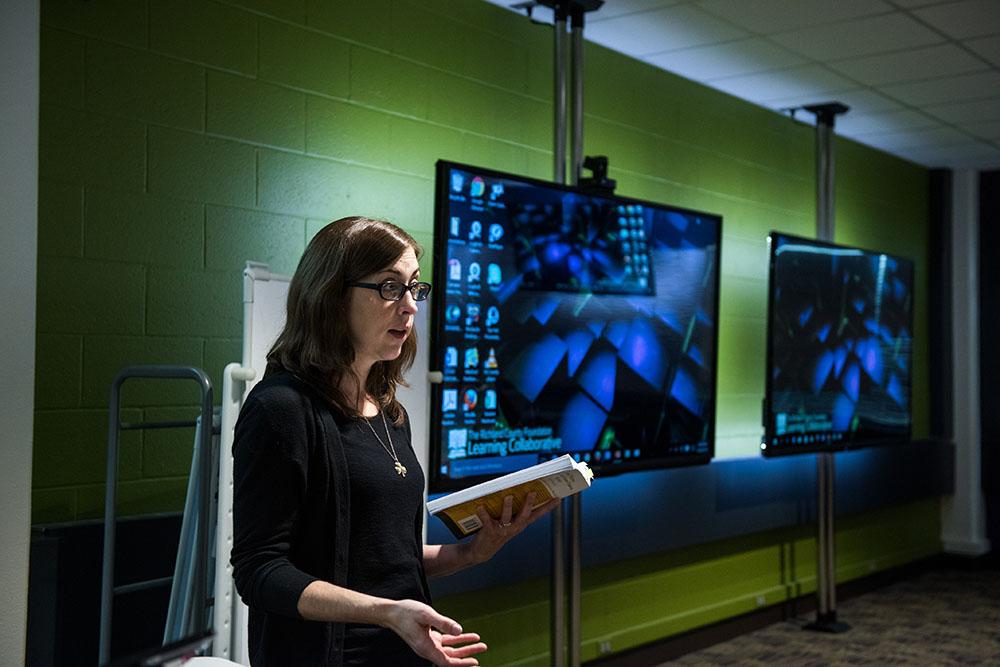Once a year, The Ohio State University at Mansfield hosts a meeting of the minds for the campus community. The Faculty Research Frenzy is when faculty gather to share their latest research. Presenters take turns showcasing their research but only have minutes to do so and then quickly pivot into the next presenter, hence the name “frenzy.”
On Wednesday, March 20, four of Mansfield’s finest took the stage to talk about their current research. Representing totally different disciplines, those in attendance learned about modern adaptations of Shakespeare, a new invasive insect, infection duration of bacteriophages, and fMRI responses to color appearance all in a matter of minutes.
Learn more about our faculty’s exciting research below.
Note: two presenters were not able to attend the event, but their research is also included.
Dr. Elizabeth Kolkovich | Department of English
Shakespeare Without Misogyny?
My talk shares what I learned from studying the performance history of one scene in Shakespeare and Thomas Middleton’s Timon of Athens. I analyze how two recent productions managed to perform this scene in a less misogynist way than their predecessors have, and I propose another option: to interpret the original text as more nuanced and ambiguous than critics and directors have read it.
Dr. Gabe Karns | School of Environment and Natural Resources
Spotted Lanternfly CSI
Spotted lanternflies (SLF) are an invasive insect that feed in huge aggregations by sucking up a tree’s sap through their stabbing mouthpart. Among the native trees likely to be impacted, maple (Acer spp) are particularly worrisome because sugar makers are also interested in the sugary sap of maple trees to produce maple syrup. Excepting one microcosm study on 18 maple saplings in Pennsylvania, we know next to nothing about the potential impacts of SLF on our native maples and resulting implications to Ohio maple producers. Efforts are ongoing to cleverly use citizen science to better understand the effects of SLF on maple trees’ stored non-structural carbohydrates and the amount of sugar in sap harvested by maple producers.
Dr. Steve Abedon | Department of Microbiology
Comparative Bacteriophage Infection Duration
Bacteria are small cells that are ubiquitous in environments while bacteriophages (phages) are even-smaller viruses that infect only bacteria. I study the evolutionary ecology of bacteriophages, which is trying to understand how they "behave" and why. My core interest is in how long individual phages infect individual bacteria, which can range from ten minutes to multiple hours to effectively indefinitely. Right now, I am analyzing this characteristic under crowded conditions in 60 or so different phage lineages by using an array four automated machines able to simultaneously keep track of 30 individual, up to 99-hour experiments each, as I will describe. During the same experiments I have also been exploring the potential for something called antagonistic coevolution, a.k.a., evolutionary arms races.
Dr. Del Lindsey | Department of Psychology
Functional Magnetic Resonance Imaging of Human Brain Responses Related to Color Appearance
Undergraduate psychology textbooks have long taught Ewald Hering’s opponent-process theory of color appearance, which states that human understanding of color is influenced by neurons in the brain that encode color in ways that signal redness vs. greenness and blueness vs. yellowness. While Hering’s theory has been validated behaviorally, no one has found its neurophysiological basis. Using statistical analyses of functional MRI brain responses recorded from human subjects, we have found that a color-selective cortical area called V4 responds in a Hering-like manner, but only when subjects perform a Hering color appearance task while in the scanner. In addition to revealing a neurophysiological correlate of Hering’s theory, these results show that color-selective regions of the brain are not hard-wired but respond flexibly, depending on the task the subject is asked to perform. We speculate that high-level cognitive processes, some perhaps related to language, account for this flexibility.
Dr. Carol Landry | Department of Ecology, Evolution, and Organismal Biology
The Whole Is Often Greater Than the Sum of Its Parts: How Species Interactions Drive Biodiversity
The complex nature of communities cannot be understood by simply listing the species present and their relative abundances – this is merely the starting point. Interactions between those species are critically important to the maintenance of community-level biodiversity. My research program addresses how direct and indirect interactions between plants and insects impact the community as a whole. While my primary focus has been on plants and their pollinators, I also consider the impacts of herbivory and seed predation on plant reproductive success, as well as the impacts of parasitism and predation on pollinator reproductive success.
Dr. Tim Berra | Department of Ecology, Evolution, and Organismal Biology
The Moai of Easter Island
I am writing a book entitled the Peopling of Polynesia. Polynesia occupies one-third of the earth’s surface within the triangle formed by the Hawaiian Islands, Easter Island (Rapa Nui), and New Zealand. Rapa Nui and New Zealand were the last uninhabited places on earth to be colonized by humans about 800 years ago (1200 CE). Rapa Nui is one of the most remote places on earth-- 2,300 miles off the coast of Chile. It is known for its gigantic statues (moai) as well as for its ecological collapse. The moai represent ancestor worship, not gods. The 877 statues were carved from volcanic tuff between 1100-1600 CE to capture the power (mana) of a chief or village “big man”. An average moai was 13 ft tall and 27,500 lbs. Some were many times that size. How were these giants carved and transported as far as 15 miles by prehistoric people?
